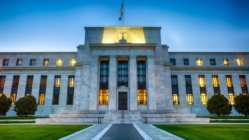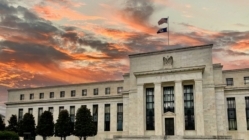
Mr. Gromen believes that the Fed and the U.S. government have no choice but to continue to push rates down in whatever way possible in order to finance our massive federal deficits.
The Fed often makes the case that low rates are here to stimulate the economy but low rates also help the government to afford massive borrowing, as higher rates could bankrupt the entire system, according to Gromen.
Gromen further points out that non-discretionary federal spending (defense, entitlements, and debt payments) that cannot be adjusted now exceeds tax revenues by about 140%, as a result of COVID slowdowns and COVID-related borrowing.
So, we can expect a lot more borrowing and a lot more actions by a desperate Fed to keep rates as low as possible – mostly by purchasing bonds via Quantitative Easing.
Gromen’s prediction of negative interest rates caught my ear because another macroeconomist, Raoul Pal, predicted negative rates on the same podcast two weeks earlier here.
And, I have heard several other podcasts in recent months with similar predictions by former central bank advisers and other economists.
WHAT ARE NEGATIVE INTEREST RATES?
Negative rates occur when lenders are willing to get paid back with less money than what they loaned originally.
Something like this: “Hi Bob, I will loan you $1,000, but only if you agree to only repay me $990.”
What it really means in practice is that banks and financial institutions have to pay central banks to keep their excess reserves parked at a central bank (like the Fed) instead of receiving interest.
Institutions are willing to do this because they have no place else to park their funds.
And central banks offer negative rates to keep borrowing costs low and in an effort to get banks or institutions to lend or to spend money (to stimulate the economy) instead of just saving it.
Japan and Europe have already experimented with negative rates, and it primarily involved the rates their central banks paid to institutions for storing excess reserves (similar to our Fed Funds Rate).
Negative rates do not mean that mortgage and 10 Year Treasury rates will be negative.
The potential for negative rates does mean that mortgage rates will likely fall again – at least for a while – until inflation returns (but nobody seems to be in agreement in regard to when that will happen).
HOW THIS AFFECTS MORTGAGES/REAL ESTATE
If the U.S. slides into negative rate territory, mortgage rates could fall another 1/4 to 1/2 percent. I am quoting 2.75% today for a no points loan, so a quote as low as 2.25% in a negative rate world would not be out of line.
Here are a few considerations in light of this.
- Everyone will likely refinance again, as rates continue to fall. This of course would be another boon for the mortgage industry, and likely foster more capacity issues.
- Don’t pay points. We recently had a borrower pay $30,000 in points to buy down her interest rate for her jumbo loan. We discouraged it though because we think she is so likely to refinance again if and when rates drop (which appears likely). If this happens, her $30,000 in points will have been effectively wasted.
- Don’t stress over getting a rock-bottom rate. This is a point I make often irrespective of the rate environment. Borrowers stress far too much about timing the market and/or getting the lowest possible interest. I say this b/c few borrowers keep their loans for more than 4 to 7 years in any case b/c life events and/or changing rates result in refinances in most cases. And when rates are so likely to drop again, refis are that much more likely.
- Inflation. Many economists remain worried about deflation now, but with all the Quantitative Easing, borrowing, spending, and money creation, inflation will likely set in at some point. This will push up interest rates along with hard asset (such as real estate) prices in most cases. In the short run, higher rates could adversely impact housing prices because borrowing costs will be higher. But in the long run, housing remains a good inflation hedge, like we saw in the 1970s, as I have mentioned many times now.
Questions? Keep In Touch With JVM Lending
If you have questions about the homebuying process or how to qualify for a mortgage, contact JVM Lending. Our expert Mortgage Analysts and Client Advisors are available 7 days a week to answer questions and guide you through the homebuying process.
Jay Voorhees
Founder/Broker | JVM Lending
(855) 855-4491 | DRE# 1197176, NMLS# 310167
























